
 |
 |
| The Villa | Links | Guest Houses |
| The Garden | Species of plants | The Pavilion | The old kitchens | The cellars | Verbania and the lakes area |
| Weddings | Receptions | Conventions | Events | Useful information | Churches |
| The Villa | The Garden | Camellias | The cellars | The old kitchens | The pavilion | Mix |
| History | Contacts | Where we are |
Genealogy of the family Rusconi-Clerici
The town of Pallanza was founded in Roman times and was for centuries the scene of many conflicts and changes of authority, due to its strategic position half way up the lake, which was sometimes frontier, sometimes battleground between warring parties of knights, pirates, and bishops.
In more modern times the Piedmontese shore of Lake Maggiore was “discovered” by the Italian upper classes only after Italy’s independence from Austrian domination (1859). During the War of Liberation, battles were fought and daring raids carried out along the lake’s shores by patriots and Garibaldi’s soldiers.
In the second half of the 19th century the development of the railways and the growth of steamer services made the lake an increasingly attractive holiday destination.
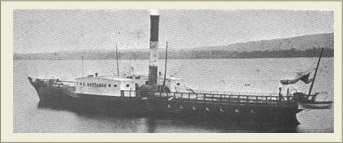
Summer villas of increasingly impressive size were built all along the shore from Arona to Cannobio, often by aristocrats from northern Europe. English, German and Russian visitors were attracted by the mild climate and the romantic atmosphere made famous by the tradition of the Grand Tour, when the sons of the intelligentsia of Europe took the road over the Simplon in search of classical antiquities, travelling from Rome to Florence, from Venice to Naples and then on to the East.
This lively new interest in the lake as a focus for culture and high society (significant the presence of the leading Italian painters of the time) was accompanied towards the end of the 19th century by a rapid development of industry, fuelled by power produced in the valleys of the hinterland, with their plentiful supply of manpower and wood.
Cossogno, near Pallanza, was the site of the world’s first hydroelectric power station, with public street lighting.
The construction of the Simplon Tunnel and the opening of the world’s first motorway – from Milan to Sesto Calende (1924) – crowned the area’s development.
At the same time, a number of magnificent villas were built in Pallanza, those on the lake shore particularly beautiful by virtue of their privileged situation.
In this period, “modern” botanical gardens were being laid out in northern Italy, inspired by the English-style gardens in Caserta or the botanical gardens at Lucca and Florence. Exotic plants brought to Europe from the East by travellers and English gardeners – azaleas, rhododendrons, camellias, camphor trees and magnolias – enlivened the geometric layout of the formal Italian gardens with an explosion of colour.
After the second war of independence in 1859, Stefano Türr, a Hungarian patriot and colonel in Garibaldi’s army, took up residence in the small Bozzotti villa, built where the present Rusconi-Clerici villa now stands.
 Türr was an extraordinary character: a colonel in the Austrian army, he deserted and enlisted under Garibaldi. He fought with the “Thousand” against the Bourbons and with the “Hunters of the Alps” against the Austrians. He was later made a general in the Royal Army. Husband to one of Napoleon’s grand daughters, he directed the building of the Corinth Canal and later also the Panama Canal. He was Governor of Naples, fought in the Crimea, took refuge in Turkey to escape the Austrian death sentence, and was pardoned due to the intercession of Queen Victoria, becoming aide-de-camp to the King of Savoy and a senator in the Kingdom of Italy.
Türr was an extraordinary character: a colonel in the Austrian army, he deserted and enlisted under Garibaldi. He fought with the “Thousand” against the Bourbons and with the “Hunters of the Alps” against the Austrians. He was later made a general in the Royal Army. Husband to one of Napoleon’s grand daughters, he directed the building of the Corinth Canal and later also the Panama Canal. He was Governor of Naples, fought in the Crimea, took refuge in Turkey to escape the Austrian death sentence, and was pardoned due to the intercession of Queen Victoria, becoming aide-de-camp to the King of Savoy and a senator in the Kingdom of Italy.
We like to think that some of the rhododendrons and camellias in the garden were planted by this spirited foreigner who came to Italy to fight for a romantic ideal of liberty and stayed to become an Italian citizen.
The oldest picture we have of the estate was taken in 1857 and shows the garden as seen from the island of San Giovanni.
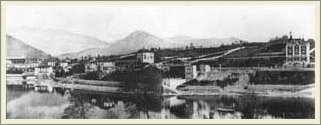
The beach is shown covered with slabs of granite being processed and a path follows the shoreline, crossing a curious little hump backed bridge in front of the moorings.
It was only at the end of the century that the garden was extended as far as the lake and this path disappeared, probably also due to the fact that the level of the lake rose when the Ticino River was dammed at Sesto Calende.
The small villa Bozzotti was originally sited where Villa Biffi, now Villa Rusconi-Clerici, stands. The lemon houses have remained where they were. The boat dock had not yet been built and the steps going down to the lake were in front of the villa.
The camellias came, almost certainly, from the Rovelli nursery, one of the best known Italian growers of acidophilous plants at that time. This nursery was only 300m from the villa and was founded by the grandsons of the Rovelli who was gardener to the Borromeo family and at the end of the 18th century transformed Isola Madre from citrus grove into formal gardens.
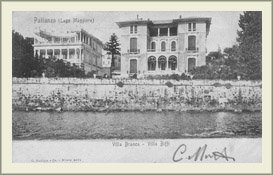
At the end of the 19th century the original villa which had been the home of Türr was demolished and in its place a much larger villa in the eclectic style with rich neo-baroque decorations was built. The scale of the new house may have had something to do with the fact that the owner, Ferdinando Biffi, and his son were both very tall, being over six foot six, and wanted the house to be built to suit them.
Below is a reproduction of the pages devoted to Villa Biffi in the book “Ville e Castelli. Edizioni tecnografiche” (1907)
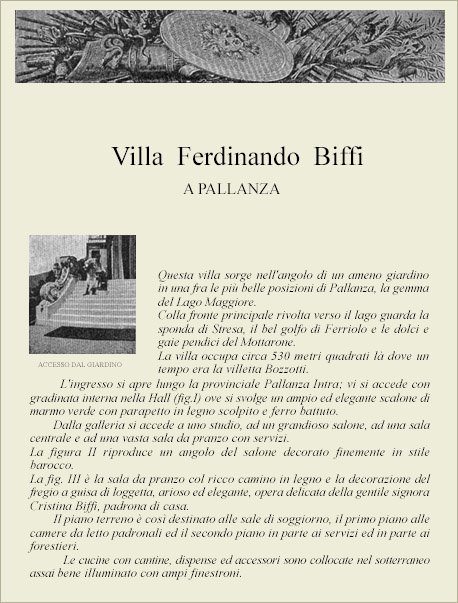
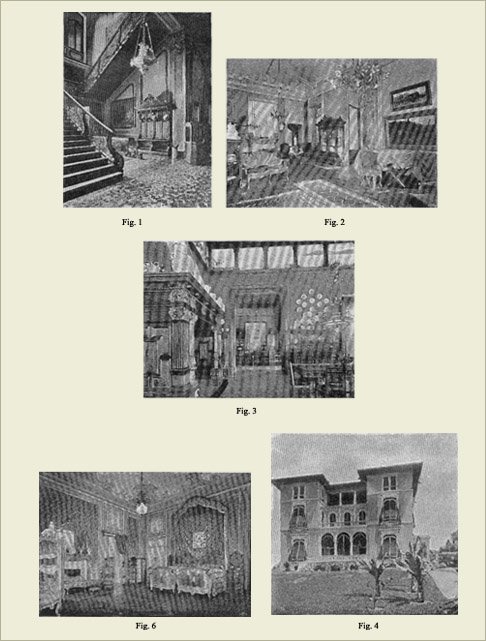
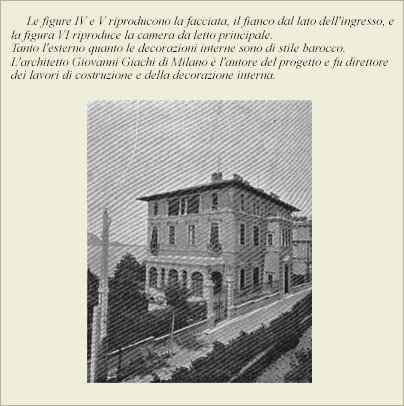
But this description hardly does justice to the grandeur of the building, accentuated by the grand staircase with its wood and wrought iron balustrade anticipating the Art Nouveau style.
And today, almost a century later, the magical atmosphere of the house still enchants visitors, as they watch the rippling light patterns of the water reflected on the caisson ceiling.
When we look at the old photographs of the beginning of last century, we are always proud to see that only some of the original furnishings have been replaced; most of the light fittings, wood panelling, sofas, tables and chairs have been preserved as they were.

In fact, just a few years ago we came across the old photograph album of the Biffi family, in which along with photographs of Ferdinando and Cristina Pirinoli and their son Gianni there were also photographs of the interior of the villa, with our armchairs, mirrors, chairs, as well as glimpses of the garden, and, wonder of wonders! the motorboat, families, friends and children of the time.
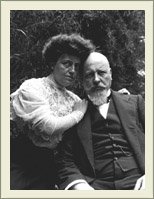
It was a joy to see through our adult eyes a world we had dreamed of as children, to actually see the faces of the men and women who put their hearts and their intelligence, not to mention their hard work, into creating this marvellous place.
We should remember that behind the existence of every great building, crimes and injustices may have been perpetrated in its name and in the name of the power it represented or guaranteed – but these were also places of love, impossible dreams, heartfelt poetry, and every kind of good and evil that men can create.
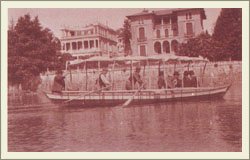
But now just think positive: think how a villa and its garden can represent a courtly dream, a traveller’s refuge, a lover’s secret longing, and imagine how precious this place is to us, no longer courtiers, travellers or lovers.
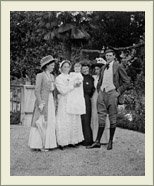
Imagine this great house in the days of the Belle époque, when it was the scene of weddings, ceremonies and parties. Then the house hosted artists such as the Troubetzkoy brothers, Tominetti and Ranzoni, military men such as General Cadorna and Commander Rizzo della Beffa di Buccari, the aristocratic families from the other villas on the lake: the Pallavicinis, the Manca di Villahermosas, the Ammans, the Melzi d’Erils. the Francforts, the Branca di Romanicos, the Browne Casanovas and the families of the nascent industrial bourgeoisie.
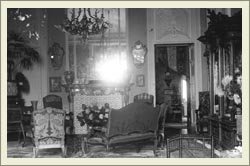
In its long history the villa has seen births and deaths, tragedies and wars; during the Second World War the drawing room on the ground floor was used as a Gestapo headquarters, and Fascist commando units tried to requisition the villa, the island of San Giovanni and the Villa Eremitaggio, apparently to house a fleet of small war boats.
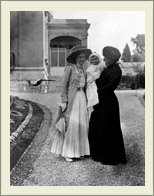
But peace returned, and now the house has embarked on its second century and the Biffi family have been succeeded by the Count Rusconi-Clericis. They have brought their dedication and commitment to bear in keeping intact the allure of this great house and its historic garden. The garden was born of the love of a foreigner for our beautiful lake, and many years later, reborn to greater splendour thanks to the strong personality of another foreigner from the north - my Prussian mother.
The old house continues to welcome its guests with the colours of the azaleas, bewitch them with the scent of the olea fragrans, and enchant them with the romanticism of the lake. And the grebes, the swans and the ducks are once again nesting on the nearby island of S. Giovanni, the post-war home of the great conductor Arturo Toscanini.